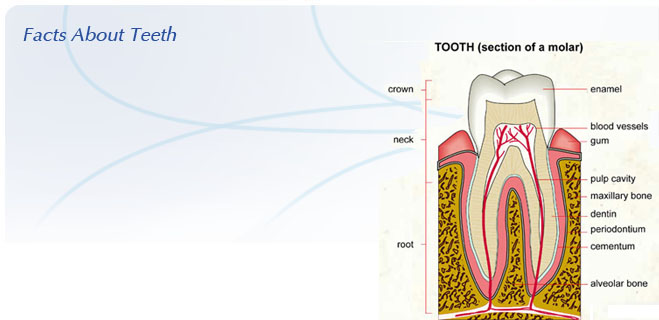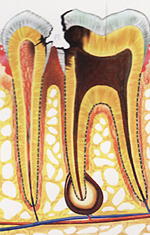
Following parts build up your teeth:
Tooth: hard organ composed of dentine and enamel, used
for biting and for chewing food.
Enamel: hard substance covering the crown of a tooth.
Blood vessels and nerves:
blood vessel: tube through which
blood circulates. Nerve: conductive strand that transmits
nerve impulses to the brain.
Gum: mucous membrane that surrounds the root of the tooth
and covers the maxillary periosteum.
Pulp cavity: tube in the root of a tooth.
Maxillary bone: bony part of the jaw.
Dentin: hard, elastic substance of a tooth.
Periodontium: tissue that supports the tooth.
Cementum: tissue that covers the root of a tooth.
Alveolar bone: bone into which the teeth are set.
Root: part of the tooth implanted in the gum.
Neck: division between the crown and root of a tooth.
Crown: visible part of a tooth.


Dental caries, also described as "tooth decay" or "dental cavities", is an infectious disease which damages the structures of teeth. The disease can lead to pain, tooth loss, infection, and, in severe cases, death.
Tooth decay is caused by certain types of acid-producing bacteria (specifically Lactobacillus species, Streptococcus mutans, and Actinomyces species) which cause damage in the presence of fermentable carbohydrates such as sucrose, fructose, and glucose.
The resulting high levels of acidity from lactic acid in the mouth affect teeth because a tooth's special mineral content causes it to be sensitive to low pH. Specifically, a tooth (which is primarily mineral in content) is in a constant state of back-and-forth demineralization and remineralization between the tooth and surrounding saliva.
When the pH at the surface of the tooth drops below 5.5, demineralization proceeds faster than remineralization (i.e. there is a net loss of mineral structure on the tooth's surface).
This results in the ensuing decay. Depending on the extent of tooth destruction, various treatments can be used to restore teeth to proper form, function, and aesthetics, but there is no known method to regenerate large amounts of tooth structure.
Instead, dental health organizations advocate preventive and prophylactic measures, such as regular oral hygiene and dietary modifications, to avoid dental caries.

In dentistry, calculus or tartar refers to calcified deposits on the teeth, formed by the continuous presence of dental plaque. Its rough surface provides an ideal medium for further plaque formation, threatening the health of the gingiva. Calculus absorbs unaesthetic stains far more easily than natural teeth.
Calculus accumulations occur in the absence of adequate oral care. Once formed, it is generally too firmly adherent to teeth to be removed with anything available to an individual at home; patients with calculus must therefore visit their dental professionals so that the calculus can be removed with ultrasonic tools and specialized sharp instruments.
Prevention:
The best way to prevent the build up of calculus is through twice daily toothbrushing and flossing and regular cleaning visits based on a schedule recommended by the dental health care provider. Calculus accumulates more easily in some individuals, requiring more frequent brushing and dental visits. There are also some external factors that facilitate the accumulation of calculus, including smoking and diabetes.


Dental plaque is biofilm (usually colorless) that builds up on the teeth. If not removed regularly, it can lead to dental cavities (caries) or periodontal problems (such as gingivitis).
The microorganisms that form the biofilm are almost entirely bacteria (mainly Streptococcus mutans and anaerobes), with the composition varying by location in the mouth. Examples of such anaerobes include fusobacterium and Actinobacteria.
The microorganisms present in dental plaque are all naturally present in the oral cavity, and are normally harmless. However, failure to remove plaque by regular tooth brushing means that they are allowed to build up in a thick layer. Those microorganisms nearest the tooth surface convert to anaerobic respiration; it is in this state that they start to produce acids.
Acids released from dental plaque lead to demineralization of the adjacent tooth surface, and consequently to dental caries. Saliva is also unable to penetrate the build-up of plaque and thus cannot act to neutralize the acid produced by the bacteria and remineralize the tooth surface.
They also cause irritation of the gums around the teeth that could lead to gingivitis, periodontal disease and tooth loss.
Plaque build up can also become mineralized and form calculus (tartar).